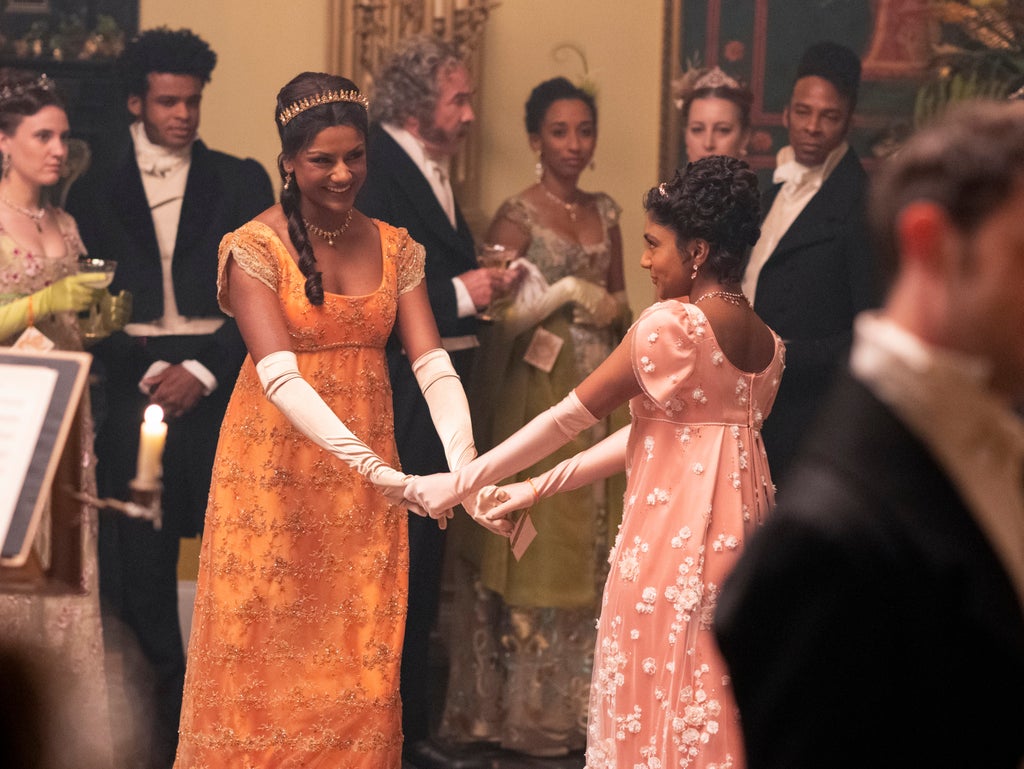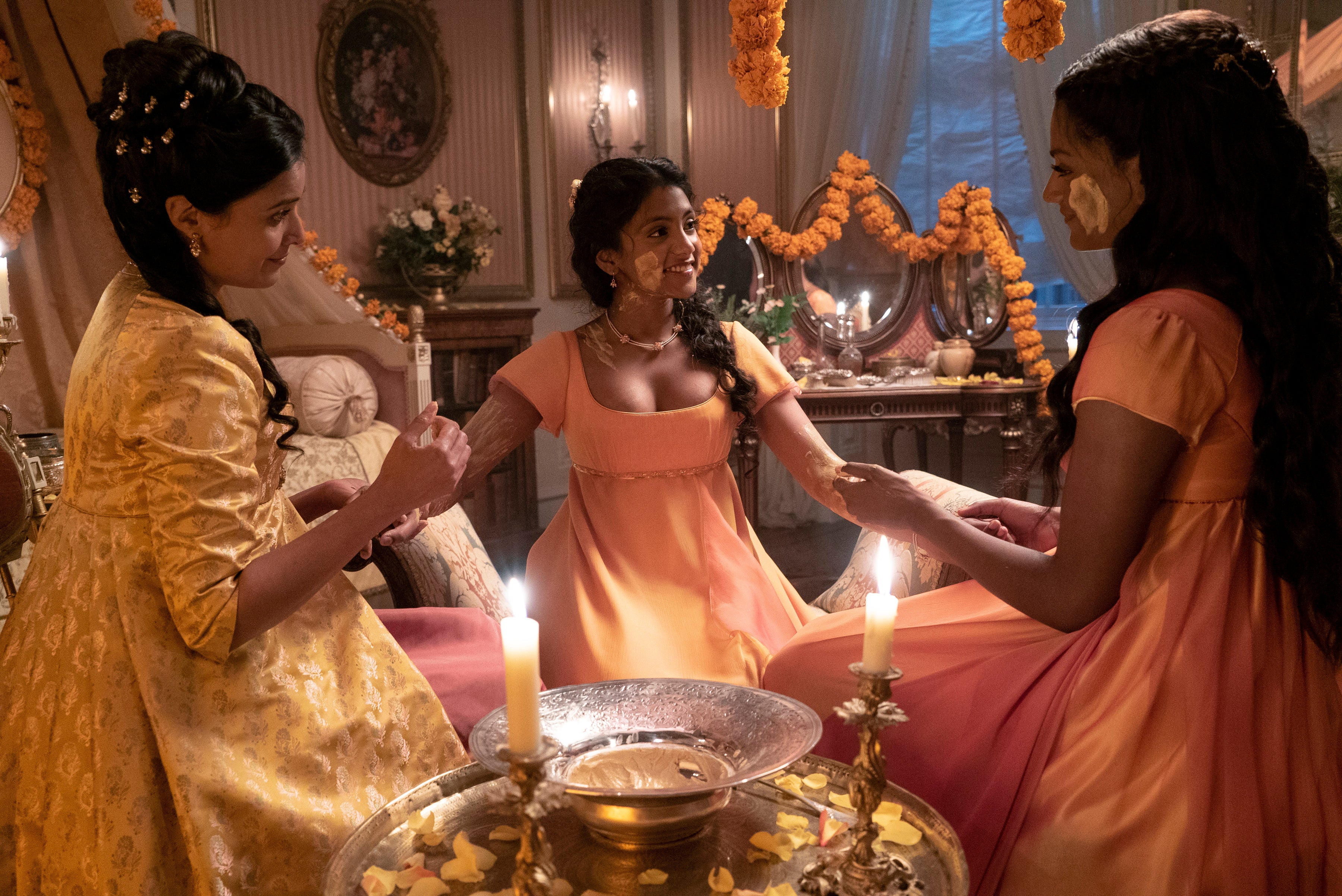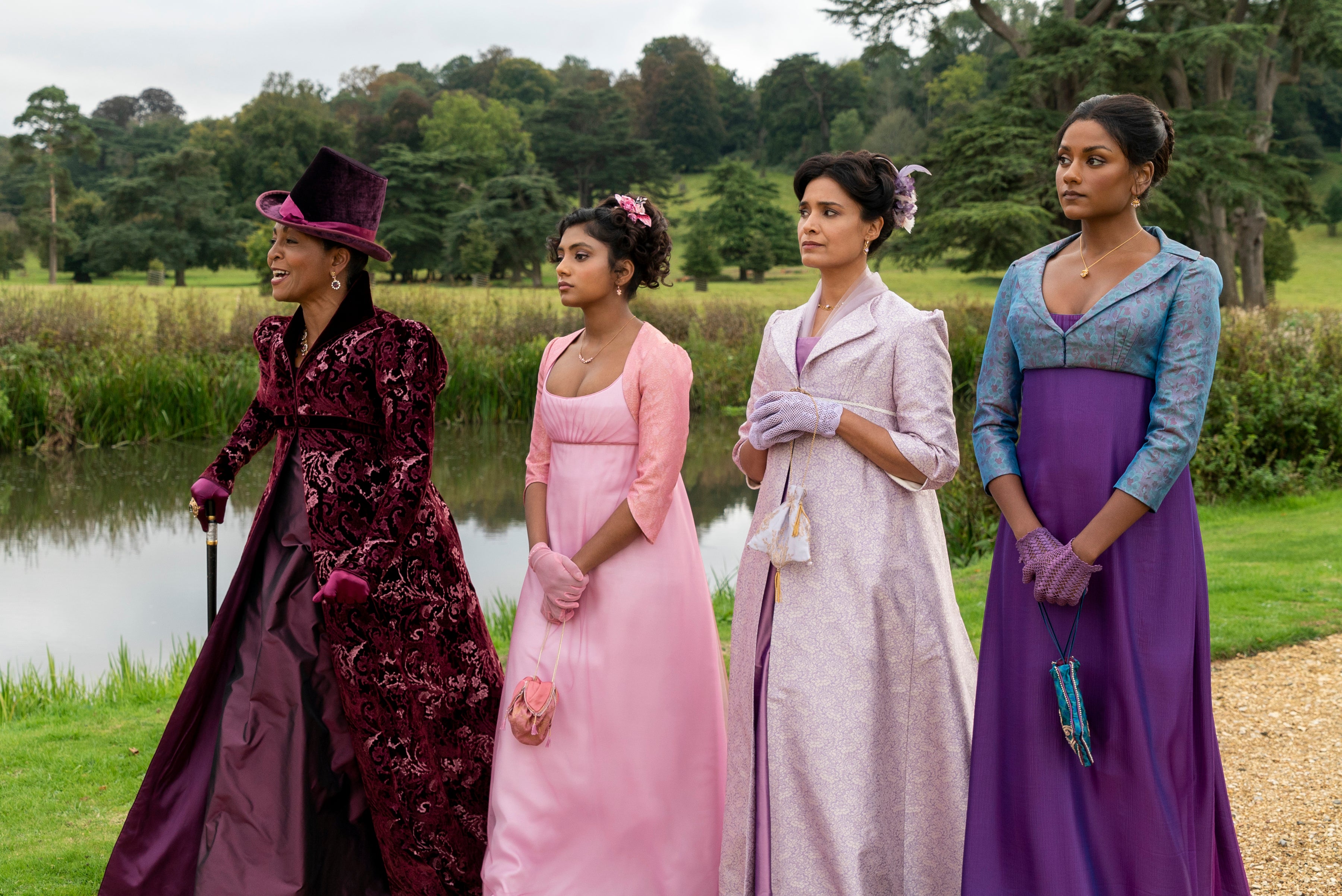
“Bridgerton has given me hope that we are now at the cusp of change and a new era of representation”, says Sebina Hussain, a content creator and avid fan of the hit Netflix series.
As people finish their binge-watching of the long awaited second season of Bridgerton, which follows the story of Regency-era families as they navigate love and scandal, women like Sebina have rejoiced at its rare representations of south Asian females on screen.
This season’s leading ladies, Kate Sharma – played by Sex Education’s Simone Ashley – and Edwina Sharma – played by Charithra Chandran – are both of south Indian, Tamil heritage. They have been fan-favourites for their love triangle and enemies-to-lovers storylines featuring viscount Anthony Bridgerton, played by Jonathon Bailey.
Like in the first season of the hit show, which is the most-viewed English-language series on Netflix, people have been able to celebrate in the unique portrayal of people of colour in period dramas, a genre which they’re often left out of.
“There’s an enormous impact to seeing yourself, or not seeing yourself, on screen to people’s self-perception, identity and self-esteem,” say Kiran Hothi and Sonam Kaur, co-founders of community platform Not Your Wife. “Television doesn’t just reflect culture, it shapes it.”
So, The Independent chatted with young, South Asian women and Bridgerton fans on their thoughts on the representation, storylines and favourite moments in the drama’s second season.

Remina Nair, 28, a music journalist from London of a south Indian background, said she is a big fan of period dramas, in general, with Bridgerton standing out to her due to the diversity of its cast.
On the new season, she said: “When I heard about the new south Asian leads, I was excited to watch them and when I saw that the actresses had darker skin it made me even happier.
“It’s great that a show is highlighting south Asian talent that deviates from the lighter skin actresses that is usually represented in mainstream western media and Bollywood,” she added.
Growing up, Remina said she often didn’t see actresses who looked like her and enjoyed witnessing Netflix using actresses with darker skin tones. She said: “If I saw more darker skin actresses represented at a younger age, I feel my internal insecurities about my skin colour wouldn’t have been as prevalent as I would have seen a wider representation of skin colours.”
On this season’s leading ladies, Remina said: “It was great seeing south Asian culture represented through Kate and Edwina. What I really enjoyed was seeing two south Asian women becoming the love interests. It was great that their beauty was celebrated, and I haven’t seen south Asian women at the centre of a romance plot before.
“I think some of my favourite parts was when south Asian culture was represented within the scenes, this could be through the music or even jewellery used.” Remina continued. “From the classical renditions of Asian music to the haldi (turmeric) ceremony to the hair oiling scene - it was great to see a period drama highlight south Asian culture.”

The lack of representation of south Asian women is something Kiran Hothi and Sonam Kaur, co-founders of Not Your Wife, are particularly aware of.
As a platform, Not Your Wife focuses on amplifying and celebrating south Asian women while providing a safe space for them to explore and discuss communal experiences. Through a combination of social media, journalism, events, partnerships, they put a spotlight on the talents of their community of over 35,000 people on Instagram alone.
On portrayals of south Asian women in the media, Kiran and Sonam say they are “noticeably absent” despite being the largest ethnic minority in the UK, according to the last census, which is one of the reasons they created their platform.
They said: “Prior to Bridgerton, its difficult to pinpoint the last time we witnessed a South Asian woman cast as the lead in a show as mainstream and successful. Or the last time we saw a south Asian woman at the forefront of a beauty campaign, a social media campaign, or as the love interest in a film. We think that speaks volumes in itself.”
They say this can impact “people’s self-perception, identity and self-esteem”, so applaud Bridgerton for its representation this season.
They said: “It’s been incredible to see Simone Ashley and Charithra Chandran’s characters and to see two South Asian women being represented as multidimensional beings, without the stereotypes of being oppressed, submissive or culture-bashing.
“We think it’s also important to acknowledge that where South Asian women have occasionally been cast in television or film, it’s typically been lighter-skinned, north Indian women with more Euro-centric features. The impact that casting Simone and Charithra has had not only for South Asian women, but particularly those who are darker-skinned, is really great.”

Beulah Rajkumar, 27, an editor from Kent who is of a British, South Indian, Sri Lankan and Tamil background said she was “shocked” to hear about the casting of this season’s leading ladies.
She said: “The representation in season one was already impressive and broke all the period drama rules, but I’ve never seen a globally successful series with the desirable female lead played by a Tamil woman.”
Both leading actresses are Tamil, an ethnic group originating in the south of India.
“Netflix gave us the first ever British series and period drama with not one, but two, South Indian Tamil leads” Beulah continued. “I felt excited to finally watch a period drama with women that look like me.”
She spoke of the lack and mis-representation of south Indians and darker-skinned south Asians across eastern and western media.
She said: “Western culture tends to define the entire South-Asian community with North Indians - Priyanka Chopra, Naomi Scott, Lilly Singh, or Bollywood. They’ve been a pivotal part of South-Asian representation, but cannot define the entire community. Then, dark-skinned Tamil women will often play ‘the friend’, ‘the lower caste girl’, or be the butt of a joke in reference to her skin complexion,” she continued.
In comparison, Beulah said the Sharma sisters in Bridgerton are portrayed as “classy, intelligent and stunning.” She said: “Edwina is even chosen as the Queen’s most desirable match of the season, the it-girl of Regency society. It’s a breath of fresh air to see dark-skinned Tamil women portrayed as alluring and interesting.
“The Sharmas are unashamed of their Indian heritage in small details,” she continued, “such as embracing their Indian accent, Kate oiling Edwina’s hair, or Kate’s distaste for English tea and so, adds cardamom and clove spices to make beloved Indian chia.”
Beulah also enjoyed Edwina’s character development from a “sweet and innocent girls-girl” who feels pressure to be desired by men to an “outspoken and uncompromising, flipping familiar narratives of the naive Asian girl.”
While she said the season is “a big win for representation”, Beulah feels there could have been less ambiguity about the Sharma’s heritage. She said: “The sisters jump from saying ‘didi’ (Hindi for elder sister) to ‘appa’ (Tamil for dad) throughout the season. Once again, culture is struggling to say the word ‘Tamil’ out loud - continuing the on-screen cliche of the generalised Indian.”

Sebinah Hussain, 30, a fashion and beauty content creator and jewellery brand owner, is from a British Pakistani background and says that Bridgerton got this season “so right” whereas others often miss the mark.
“I often find myself cringing when a show tries to be more culturally diverse, but Bridgerton got it so right,” she said. “I love that the Sharma girls were always dressed in beautiful English gowns but then there were little nods to the culture - Kate’s gold jewellery pieces, her paisley print shawl for bedtime or the banarsi scarf she wears.
“As a brown girl, you are often left on the side-lines wondering what or where your place is in society, so this was not only a joy to watch, but deserves credit for executing the diversity element so well.”
Sebinah also loved the use of makeup in the show. She said: “It was such a breath of fresh air to see two brown women in light, natural make-up, in comparison to the Bollywood movies I watched growing up.
“I loved that they used pink blush,” she continued. “I am sure I am not the only South Asian girl who was told she was ‘too brown’ for pink blusher growing up. Kate’s eyes were always so beautifully lined and I am so happy they chose actresses with deeper skin tones.

“I don’t think the directors or the cast understand how much of a positive impact this representation will have for so many women, but also for so many young girls, who are dealing with a colour complex.”
“The reality is that the roles of Edwina and Kate did not need to be South Asian, but to see two lead roles created in a show that was so hugely popular during season one, to see the boundaries be changed and opportunities be created gives me so much hope,” she continued.
“I think back to how excited I was to see the Patel sisters’ in Harry Potter and how at the tender age of 13, I cringed in my cinema seat when I saw the horrible pink and orange dresses they had been put in. Since then, I have always been left disappointed by south Asian representation, but Bridgerton has given me hope that we are now at the cusp of change and a new era.
“I hope it inspires other directors to create similar roles and opportunities and to push for higher and better standards of diversity within the film and TV industry.”
Kiran and Sonam from Not Your Wife added: “While it’s been amazing to see this kind of representation on-screen and we hope it continues, we truly believe that in order to create authentic, and long-lasting change, more work needs to be done off-screen - more south Asians need be behind-the-scenes in the writers rooms, the directors’ chair, behind the camera and consulting on shows.”
Bridgerton is streaming on Netflix now.







